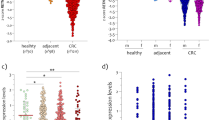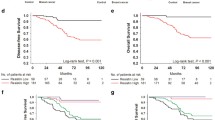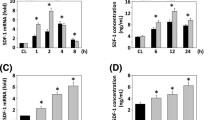Abstract
Previous studies have indicated that resistin-like molecule beta (RELMβ), an intestinal goblet cell-specific protein, is markedly increased in the intestinal tumors of min mice and over-expressed in a human colon cancer cell line. We hypothesized that RELMβ might be enhanced in human colon cancer. The aim of this study was to examine the clinical importance of RELMβ expression in colon cancer patients and to correlate its expression with various clinicopathological parameters, upstream regulatory molecule expression, tumor proliferative capacity, and patients’ survival. Of the 80 colon cancer patients studied, 65 (81.25%) tested positive for RELMβ, mainly in the cytoplasm of colon mucosa. Contrasting sharply with the strongly RELMβ-positive tumors, normal colon mucous membrane was negative or weakly positive. RELMβ positivity in colon cancer was correlated with histological grade of differentiation and lymph node metastasis, but not with age, gender, tumor location and size, tumor infiltration, Dukes’ stage, liver metastasis, and venous invasion. RELMβ expression was significantly correlated with the expression of transcription factor CDX-2 (P < 0.01) but not with that of proliferative index Ki-67 (P > 0.05). The mean postoperative survival time (2.76 years) of RELMβ-positive patients was significantly longer than that (1.26 years) of RELMβ-negative patients (P = 0.032). These findings support evidence of the enhanced RELMβ expression in colon cancer patients and suggest that further investigation is warranted to explore the role of RELMβ in colon cancer.




Similar content being viewed by others
References
Roy HK, Smyrk TC, Koetsier J, Victor TA, Wali RK (2005) The transcriptional repressor SNAIL is overexpressed in human colon cancer. Dig Dis Sci 50:42–46. doi:10.1007/s10620-005-1275-z
Uchino H, Kataoka H, Itoh H, Sekiya R, Onitsuka T, Koono M (1999) Roles of intestinal trefoil factor (ITF) in human colorectal cancer: ITF suppresses the growth of colorectal carcinoma cells. Hum Cell 12:181–188
Laboisse C, Jarry A, Branka JE, Merlin D, Bou-Hanna C, Vallette G (1995) Regulation of mucin exocytosis from intestinal goblet cells. Biochem Soc Trans 23:810–813
Poulsom R, Wright NA (1993) Trefoil peptides: a newly recognized family of epithelial mucin-associated molecules. Am J Physiol 265:G205–G213
Aksoy N, Akinci OF (2004) Mucin macromolecules in normal, adenomatous, and carcinomatous colon: evidence for the neotransformation. Macromol Biosci 4:483–496. doi:10.1002/mabi.200300099
Byrd J, Bresalier R (2004) Mucins and mucin binding proteins in colorectal cancer. Cancer Metastasis Rev 23:77–99. doi:10.1023/A:1025815113599
Shaoul R, Okada Y, Cutz E, Marcon MA (2004) Colonic expression of MUC2, MUC5AC, and TFF1 in inflammatory bowel disease in children. J Pediatr Gastroenterol Nutr 38:488–493. doi:10.1097/00005176-200405000-00006
Taupin DR, Kinoshita K, Podolsky DK (2000) Intestinal trefoil factor confers colonic epithelial resistance to apoptosis. Proc Natl Acad Sci USA 97:799–804. doi:10.1073/pnas.97.2.799
Steppan CM, Brown EJ, Wright CM, Bhat S, Banerjee RR, Dai CY, Enders GH, Silberg DG, Wen X, Wu GD, Lazar MA (2001) A family of tissue-specific resistin-like molecules. Proc Natl Acad Sci USA 98:502–506. doi:10.1073/pnas.98.2.502
Artis D, Wang ML, Keilbaugh SA, He W, Brenes M, Swain GP, Knight PA, Donaldson DD, Lazar MA, Miller HRP, Schad GA, Scott P, Wu GD (2004) RELM{beta}/FIZZ2 is a goblet cell-specific immune-effector molecule in the gastrointestinal tract. Proc Natl Acad Sci USA 101:13596–13600. doi:10.1073/pnas.0404034101
Holcomb IN, Kabakoff RC, Chan B, Baker TW, Gurney A, Henzel W, Nelson C, Lowman HB, Wright BD, Skelton NJ, Frantz GD, Tumas DB, Peale J, Shelton DL, Hebert CC (2000) FIZZ1, a novel cysteine-rich secreted protein associated with pulmonary inflammation, defines a new gene family. EMBO J 19:4046–4055. doi:10.1093/emboj/19.15.4046
He W, Wang ML, Jiang HQ, Steppan CM, Shin ME, Thurnheer MC, Cebra JJ, Lazar MA, Wu GD (2003) Bacterial colonization leads to the colonic secretion of RELMbeta/FIZZ2, a novel goblet cell-specific protein. Gastroenterology 125:1388–1397. doi:10.1016/j.gastro.2003.07.009
Steppan CM, Lazar MA (2004) The current biology of resistin. J Intern Med 255:439–447. doi:10.1111/j.1365-2796.2004.01306.x
Stutz AM, Pickart LA, Trifilieff A, Baumruker T, Prieschl-Strassmayr E, Woisetschlager M (2003) The Th2 cell cytokines IL-4 and IL-13 regulate found in inflammatory zone 1/resistin-like molecule alpha gene expression by a STAT6 and CCAAT/enhancer- binding protein-dependent mechanism. J Immunol 170:1789–1796
Gerstmayer B, Kusters D, Gebel S, Muller T, Van Miert E, Hofmann K, Bosio A (2003) Identification of RELM[gamma], a novel resistin-like molecule with a distinct expression pattern. Genomics 81:588–595. doi:10.1016/S0888-7543(03)00070-3
Edelblum KL, Yan F, Yamaoka T, Polk DB (2006) Regulation of apoptosis during homeostasis and disease in the intestinal epithelium. Inflamm Bowel Dis 12(5):413–424. doi:10.1097/01.MIB.0000217334.30689.3e
de Santa Barbara P, van den Brink GR, Roberts DJ (2003) Development and differentiation of the intestinal epithelium. Cell Mol Life Sci 60:1322–1332. doi:10.1007/s00018-003-2289-3
McAuley JL, Linden SK, Png CW, King RM, Pennington HL, Gendler SJ, Florin TH, Hill GR, Korolik V, McGuckin MA (2007) MUC1 cell surface mucin is a critical element of the mucosal barrier to infection. J Clin Invest 117:2313–2324. doi:10.1172/JCI26705
Moehle C, Ackermann N, Langmann T, Aslanidis C, Kel A, Kel-Margoulis O, Schmitz-Madry A, Zahn A, Stremmel W, Schmitz G (2006) Aberrant intestinal expression and allelic variants of mucin genes associated with inflammatory bowel disease. J Mol Med 84:1055–1066. doi:10.1007/s00109-006-0100-2
Sasaki M, Ikeda H, Nakanuma Y (2007) Expression profiles of MUC mucins and trefoil factor family (TFF) peptides in the intrahepatic biliary system: physiological distribution and pathological significance. Prog Histochem Cytochem 42:61–110. doi:10.1016/j.proghi.2007.02.001
Banerjee RR, Lazar MA (2001) Dimerization of resistin and resistin-like molecules is determined by a single cysteine. J Biol Chem 276:25970–25973. doi:10.1074/jbc.M103109200
Kinoshita K, Taupin DR, Itoh H, Podolsky DK (2000) Distinct pathways of cell migration and antiapoptotic response to epithelial injury: structure-function analysis of human intestinal trefoil factor. Mol Cell Biol 20:4680–4690. doi:10.1128/MCB.20.13.4680-4690.2000
Wang ML, Shin ME, Knight PA, Artis D, Silberg DG, Suh E, Wu GD (2005) Regulation of RELM/FIZZ isoform expression by Cdx2 in response to innate and adaptive immune stimulation in the intestine. Am J Physiol Gastrointest Liver Physiol 288:G1074–G1083. doi:10.1152/ajpgi.00442.2004
Beck F (2004) The role of Cdx genes in the mammalian gut. Gut 53:1394–1396. doi:10.1136/gut.2003.038240
Freund JN, Domon-Dell C, Kedinger M, Duluc I (1998) The Cdx-1 and Cdx-2 homeobox genes in the intestine. Biochem Cell Biol 76:957–969. doi:10.1139/bcb-76-6-957
Li MK, Folpe AL (2004) CDX-2, a new marker for adenocarcinoma of gastrointestinal origin. Adv Anat Pathol 11:101–105. doi:10.1097/00125480-200403000-00004
Yamamoto H, Bai YQ, Yuasa Y (2003) Homeodomain protein CDX2 regulates goblet-specific MUC2 gene expression. Biochem Biophys Res Commun 300:813–818. doi:10.1016/S0006-291X(02)02935-2
Boudreau F, Rings EHHM, van Wering HM, Kim RK, Swain GP, Krasinski SD, Moffett J, Grand RJ, Suh ER, Traber PG (2002) Hepatocyte nuclear factor-1alpha, GATA-4, and caudal related homeodomain protein Cdx2 interact functionally to modulate intestinal gene transcription. Implication for the developmental regulation of the sucrase-isomaltase gene. J Biol Chem 277:31909–31917. doi:10.1074/jbc.M204622200
Drummond F, Sowden J, Morrison K, Edwards YH (1996) The caudal-type homeobox protein Cdx-2 binds to the colon promoter of the carbonic anhydrase 1 gene. Eur J Biochem 236:670–681. doi:10.1111/j.1432-1033.1996.t01-1-00670.x
Lorentz O, Duluc I, Arcangelis AD, Simon-Assmann P, Kedinger M, Freund JN (1997) Key role of the Cdx2 homeobox gene in extracellular matrix-mediated intestinal cell differentiation. J Cell Biol 139:1553–1565. doi:10.1083/jcb.139.6.1553
Sakaguchi T, Gu X, Golden HM, Suh E, Rhoads DB, Reinecker HC (2002) Cloning of the human claudin-2 5′-flanking region revealed a TATA-less promoter with conserved binding sites in mouse and human for caudal-related homeodomain proteins and hepatocyte nuclear factor-1alpha. J Biol Chem 277:21361–21370. doi:10.1074/jbc.M110261200
Traber PG, Wu GD, Wang W (1992) Novel DNA-binding proteins regulate intestine-specific transcription of the sucrase-isomaltase gene. Mol Cell Biol 12:3614–3627
Dang DT, Mahatan CS, Dang LH, Agboola IA, Yang VW (2001) Expression of the gut-enriched Krüppel-like factor (Krüppel-like factor 4) gene in the human colon cancer cell line RKO is dependent on CDX2. Oncogene 20:4884–4890. doi:10.1038/sj.onc.1204645
Marchetti M, Caliot E, Pringault E (2003) Chronic acid exposure leads to activation of the cdx2 intestinal homeobox gene in a long-term culture of mouse esophageal keratinocytes. J Cell Sci 116:1429–1436. doi:10.1242/jcs.00338
Phillips RW, Frierson HF Jr, Moskaluk CA (2003) Cdx2 as a marker of epithelial intestinal differentiation in the esophagus. Am J Surg Pathol 27:1442–1447. doi:10.1097/00000478-200311000-00006
Acknowledgment
This work was supported by National Natural Science Foundation of China (No. 30200284, No. 30600278, No. 30772359) and the Program for New Century Excellent Talents in University of China (NCET-06-0641).
Author information
Authors and Affiliations
Corresponding author
Rights and permissions
About this article
Cite this article
Zheng, LD., Tong, QS., Weng, MX. et al. Enhanced Expression of Resistin-like Molecule Beta in Human Colon Cancer and Its Clinical Significance. Dig Dis Sci 54, 274–281 (2009). https://doi.org/10.1007/s10620-008-0355-2
Received:
Accepted:
Published:
Issue Date:
DOI: https://doi.org/10.1007/s10620-008-0355-2




